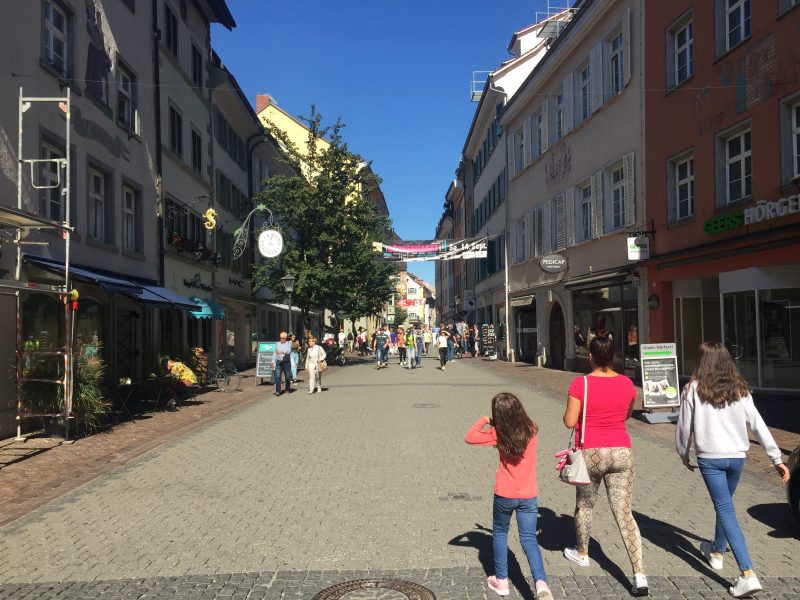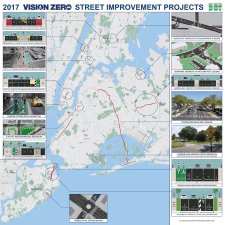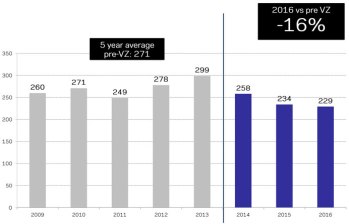Reporter’s Notebook: Mayor de Blasio’s Half-Hearted Vision Zero is a Blood-Soaked Joke

I have just returned from two weeks in Germany, and can faithfully report that Mayor de Blasio is a joke.
Obviously, we’ve all felt that before — in a year when 21 cyclists have been killed (more than double last year’s number), the mayor’s signature “street safety” net is clearly shredded. Total road fatalities are up 16 percent this year. Pedestrian deaths are up 14 percent. Cyclist deaths are up 100 percent. Vision Zero has stalled.
Pedestrians are not also dropping in higher numbers than last year — like cyclist Jose Alzorriz, they’re increasingly getting killed by drivers as they wait for a bus, stand on the sidewalk or change a traffic light.
This kind of thing doesn’t happen in Germany — or least when it does, there are immediate calls for massive, structural, anti-car change.
But from Mayor de Blasio? Silencio.
But wait, this is not just another story about how the mayor is failing to keep cyclists and pedestrians safe. (Need those? They are here, here, here and here.) But this is one of those “I’m just back from vacation” stories that reporters do when they return from some other place and realize that their beloved hometown is a pathetic backwater.
We’re not just a little behind Europe on livable streets and sustainable logistics — we’re not even on the same planet.
A few caveats: Yes, I was on vacation, which means everything (including this reporter) was the perfect version of itself. Yes, I was in Europe, which is like an America without all the partisan fighting about basic things like clean streets, public health, transit and, you know, science.
But I was also mostly in Stuttgart, which is the epicenter of Germany’s automobile industry. Porsche, Mercedes and Volkswagen are all based in this enterprising corner of southern Germany — and the companies subsidize their employees’ car purchases to ensure that there are plenty of cars always on the road. And there are.

But there are also scores of blocks that are simply off-limits to those drivers. In Germany’s Motor City, a pedestrian can walk from one end of town to the other — free from the noise and recklessness of cars. The plaza in front of the Kunstmuseum (no relation) is a constant street fair (in the good way). The Königstraße (one of the longest pedestrianized streets in Europe) is a shopping strip where neighbors run into each other without having to worry about being run over. There are other streets that are reserved solely for bikes, pedestrians and local deliveries.
The result is not just lots more street life, but an anxiety-free street life, where people truly come before cars. (Of course, there are many, many places where cars dominate in Stuttgart, but at least there are many, many places where they don’t. People certainly own cars, but the cars don’t own them.)
We have asked Mayor de Blasio — repeatedly — why he won’t bar car drivers from a handful of streets, but he simply won’t bite. Even amidst one of the bloodiest years of his mayoralty, he put out a “Green Wave” plan that did not recommend a single measure that would meaningfully restrict the places where car drivers can ruin everything. (I have been calling for DUMBO, the Brooklyn aerie that is basically a six-block cul-de-sac, to be the first pilot car-free neighborhood, but I’m apparently the only one calling for that.)
In fact, the best de Blasio offers is a weird belief that congestion pricing will make everything better. But congestion pricing is not a safety plan — in fact, it’s being partly sold as a way to speed up car travel in the city.
In any event, there will still be too many cars on the streets — and cyclists and pedestrians will still be fighting for scraps on the edges of literally every roadway in town. The vast majority of New York’s public space will be set aside — as it is now — for the storage and movement of cars, which is not only the least-efficient use of public space, but defers to a form of transportation that emits a gas that is toxic to human life.
I've seen German cities where pedestrians are not visibly stressed by the scourge of automobiles, and cyclists who have priority because they do not have to share the streets with the multi-ton death machines.
— Clayton Guse (@ClaytonGuse) September 15, 2019
This can change, of course. But who will be the driving force?
Upon my return, I reached out to the Department of Health to find out if the agency that oversees efforts to improve New Yorkers’ mental health is working on anything related to Vision Zero. For me, having enjoyed a fortnight in Europe, it’s simple: Street safety is not just about physical health, but about mental health. Residents of New York suffer high anxiety just from the noise and knowledge of the imminent danger that comes from having cars and trucks whizzing by them all day. (I’m certainly not the only person talking about this. The 99% Invisible podcast did a great episode about it earlier this year.)
Other cities around the world have eliminated cars from many areas of their central business districts, with great results for local anxiety.
Will New York? The agency hasn’t gotten back to me yet (I’ll update if it does), but Council Speaker Corey Johnson seems to get it. At a press conference on Tuesday, Johnson specifically mentioned European cities as a model for at least part of his “Streets Master Plan” bill, and also specifically mentioned how safe streets lead to calm New Yorkers.
“On the most basic level, I want a city where getting around doesn’t make people insane,” he said. “In fact, I don’t think it’s crazy to dream about a city where getting around is not just miserable, but maybe it’s actually pleasant.”
Pleasant? Here’s how
One of the other things you notice in Europe is not just how many people get around on bicycles, but how old they are.
There are more bicycle trips, of course, because the roadways are made safer for cyclists. But European cyclists are older because their governments — unlike ours — haven’t banned electric bikes. Everywhere I went, I chatted up senior citizens who simply couldn’t believe that electric bikes are illegal in New York.
For them, it’s not a political issue (most Germans, frankly, are centrists leaning right, though the Green Party is slowly ascendant), but a basic quality-of-life issue. They haven’t abandoned their cars, but they like being able to eliminate many of their daily trips because they can hop on an efficient bike. They don’t consider themselves activists.
Here in New York, of course, the mayor chose to aggressively enforce rules against electric bikes, mostly targeting low-paid delivery workers, but also sending a message to discourage the use of pedal-assist e-bikes, which he begrudgingly legalized because Citi Bike wanted to introduce them. Those e-bikes could revolutionize transportation in the city because they allow for longer trips — though when the entire e-bike fleet went out of service in April, the mayor declined to demand that they be restored immediately. They’re not slated to be back until the fall, at the earliest, yet the mayor has no problems with that.

Mostly, the mayor raises specious “safety” concerns about cyclists, most recently saying he is considering helmet laws and cyclist registration, two moves that would dramatically reduce bike-riding in a city that desperately needs more of it. The mayor’s motivation is clear: the more cyclists, the more demands for cycling infrastructure that’s expensive, time-consuming (well, when you allow every community board in town to have a say) and pisses off car owners like Whoopi Goldberg and this week’s Fort Greene yahoos who will never be satisfied anyway and who, in fact, represent the minority of New Yorkers. The mayor has built many protected bike lanes. But his efforts have slowed — and even his promise to do better, starting next year, falls well short of what Council Speaker Johnson and others are demanding. He doesn’t want to break the car culture. He wants to defend it as he does some minor tinkering under the hood.
So much energy is wasted on simply fighting for a better, more equitable use public space — energy that would be better used on solving actual problems.
Besides, concerns about safety are misplaced when the city isn’t providing enough safe infrastructure. Yes, the Spandex bros who speed around Central Park or the Hudson River Greenway are a menace, but Germany shows the way forward there, too. The country has plenty of bike racers in tight ad-covered uniforms — but they mostly stick to the thousands of miles of bike highways that connect area towns. (Yes, there are bike-only highways! Imagine being able to bike from Riverdale to Chelsea without encountering a car? That would certainly keep the Spandex bros out of Central Park!)
After a 1-year-old girl was killed on a Bronx sidewalk earlier this week, de Blasio said he “would not rest” until our streets are safe. But the mayor doesn’t need sleepless nights to solve this problem. The solution is easy: Keep cars away from people.
Gersh Kuntzman is editor of Streetsblog. When he gets really angry, he writes the “Cycle of Rage” column. Prior posts are archived here.

